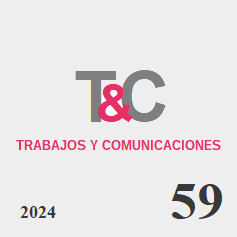The circulation of Joan de Rocaçisa’s Oviedo manuscript Vademecum in Tribulatione in Castile
Main Article Content
Abstract
Joan de Rocaçisa’s Vade Mecum in Tribulatione circulated widely in Western Europe during the XVth century. As a result, it was adapted several times over the years and the Iberian Peninsula was no exception. In Castile, the adaptation which circulated was the one in the Biblioteca Capitular de Oviedo but the context of its production had changed since the original latin text’s time. The goal of this article is to examine this version of the book by taking into account the particularities of the Castilian context as well as the modernisation and resignification this new adaptation embodied.
Downloads
Article Details

This work is licensed under a Creative Commons Attribution-NonCommercial-ShareAlike 4.0 International License.
This work is licensed under a Creative Commons Attribution 4.0 International (https://creativecommons.org/licenses/by-nc-sa/4.0/deed.es).
References
Arcelus-Ulibarrena, J. M. (2014). Las traducciones MSS en castellano del Vade Mecum in Tribulatione de Johannes de Rupescissa OFMconv (1310ca-1365). Semata: Ciencias sociais e humanidades, (26), 383-404.
Aurell, J. (2006). El nuevo medievalismo y la interpretación de los textos históricos. Hispania. Revista española de Historia, 66(224), 809-832. DOI: https://doi.org/10.3989/hispania.2006.v66.i224.21
Batllori i Munné, M. (1990). La Sicile et la Couronne d'Aragon dans les prophéties d'Arnaud de Villeneuve et de Jean de Roquetaillade. DOI: https://doi.org/10.3406/mefr.1990.3121
Mélanges de l'École ançaise de Rome. MoyenAge, 102(2), 363-379.
Bignami-Odier, J. (1952). Études sur Jean de Roquetaillade. Paris: Vrin.
Bignami-Odier, J. (1981). Jean de Roquetaillade (de Rupescissa), éologien, Polémiste, Alchimiste. Histoire littéraire de la France, (41), 75-240.
Calderón Ortega, J. M. (1998). Álvaro de Luna: riqueza y poder en la Castilla del siglo XV. Madrid: Centro Universitario Ramón Carande.
Canaparo, C. (2000). Imaginación, mapas, escritura. Buenos Aires: Zibaldone.
Canaparo, C. (2009). Geo-Epistemology. Latin America and the Localization of Knowledge. Berlín: Peter Lang.
Cartelet, P. (2016). ‘Fágote de tanto sabidor’. La construcción del motivo profético en la literatura medieval hispánica (siglos XIII-XV). Les Livres d’e-Spania Études. DOI: https://doi.org/10.4000/books.esb.1034
Ceide Rodríguez, M. (2017). El mundo cortesano de Juan II a escena. Lectura y signo: revista de literatura, 12(1), 206-219. DOI: https://doi.org/10.18002/lys.v0i12.5316
Ciola, G. (2013). Giovanni di Rupescissa: autobiografia, profezia e legenda. Micrologus, 21(21), 517-579.
DeVun, L. (2009). Prophecy, Alchemy and the End of Time. John of Rupescissa in the Late Middle Ages. New York: Columbia University Press. DOI: https://doi.org/10.7312/devu14538
Guadalajara Medina, J. (2004). El Anticristo en la España medieval. Madrid: Laberinto.
Guadalajara Medina, J. (1996). Las profecías del anticristo en la Edad Media. Madrid: Gredos.
Gómez Redondo, F. (2002). Historia de la prosa medieval castellana, vol. 3. Madrid: Cátedra.
Kaup, M. (2017). John of Rupescissa´s Vade Mecum in Tribulacione (1356): A Late Medieval Eschatological Manual for the Forthcoming irteen Years of Horror and Hardship. Oxxon: Routledge. DOI: https://doi.org/10.4324/9781315590615
Lacarra, M. J. (2016). El ciclo de imágenes del Libro del Anticristo (Zaragoza: Pablo Hurus, 1496). Revista de poética medieval, (30), 179-198. DOI: https://doi.org/10.37536/RPM.2016.30.0.50430
Lerner, R. E. (1990). Millénarisme littéral et vocation des Juifs chez Jean de Roquetaillade. En A. Vauchez (Dir.), Les textes prophétiques et la prophétie en Occident (XIIe-XIIIe s.) (pp. 311-315). Roma: École française de Rome. DOI: https://doi.org/10.3406/mefr.1990.3119
Lerner, R. E. (2007). Analecta Rupescissiana. Franciscana, (9).
Rodríguez, A. M. (1959). Benedicto XIII y el Reino de Aragón. Hispania: Revista española de historia, 19(75), 163-191.
Toro Pascua, M. I. (1999). Imagen y función del Anticristo en algunos textos castellanos del siglo XV. Via Spiritus, 6, 27-63.
Perarnau i Espelt, J. (1989). El text primitiu del De mysterio cymbalorum Ecclesiae d'Arnau de Vilanova. Arxiu de textos catalans antics, (7-8), 7-169.
Porras Arboledas, P. (2007). Juan II, rey de Castilla y León (1406-1454). Gijón: Ediciones Trea.
Pou y Martí, J. M. (1991). Visionarios, beguinos y aticelos catalanes (siglos XIII-XIV). Madrid: Cisneros.
Reeves, M. (1969). e influence of Prophecy in the Latter Middle Ages. A Study of Joachimism. Ofxord: Clarendon Press.
Roquetaillade, J. (2005). Liber ostensor quod adesse festinant tempora. Rome: École Française de Rome.
Ruiz Arzalluz, I. (2015). Diego de Moxena, el Liber sine nomine de Petrarca y el concilio de Constanza. Quaderns d'Italià, (20), 59-87. DOI: https://doi.org/10.5565/rev/qdi.383
Torrell, J. P. (1990). La conception de la prophétie chez Jean de Roquetaillade. Mélanges de l'École française de Rome. Moyen-Age, 102(2), 557-576. DOI: https://doi.org/10.3406/mefr.1990.3131
Vázquez Janeiro, I. (1988). Antricristo mixto, anticristo místico. Varia fortuna de dos expresiones escatológicas medievales. Antonianum, (4), 522-550.
Vázquez Janeiro, I. (1994). El maestro salmantino Diego Moxena de Valencia, lector de Dante y Petrarca. Salmanticensis, 41(Fasc. 3), 397-432. DOI: https://doi.org/10.36576/summa.7514
Vázquez Janeiro, I. (1999). ¿Enrique de Villena o Diego Moxena de Valencia?. En torno al autor de la primera traducción de la Divina Commedia (s.XV). Antonianum, (1), 2-51.
